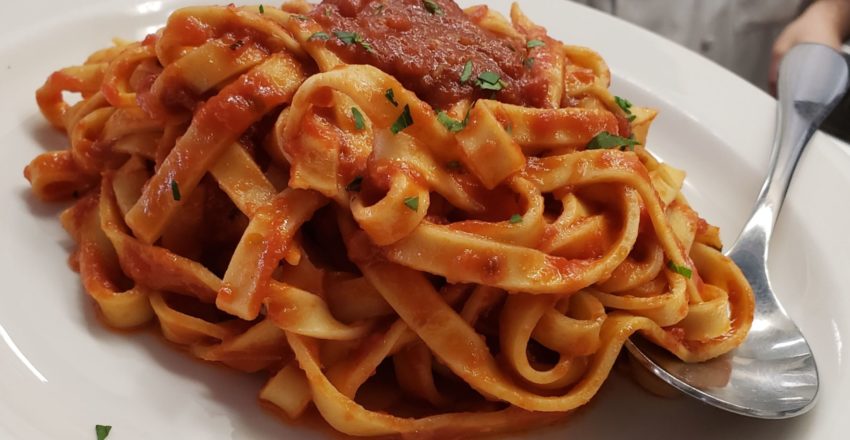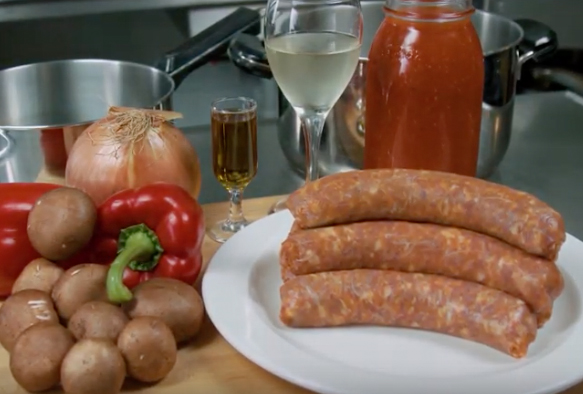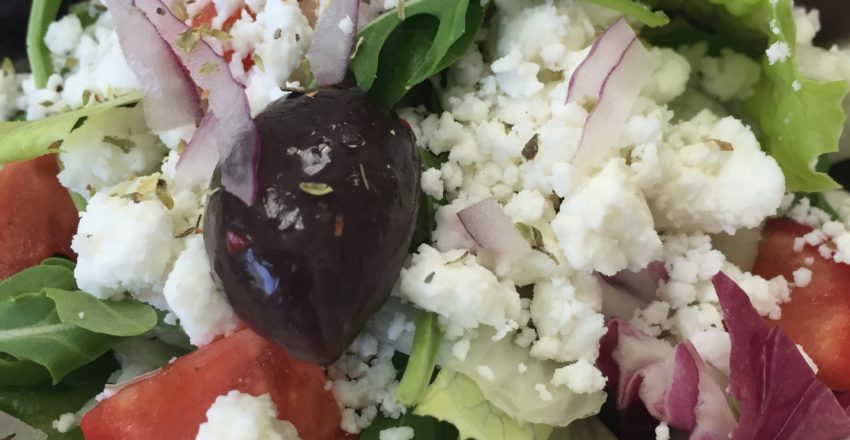
Frequently bubbling away on our burners here at Il Porcellino is a large pot of sugo Bolognese. Probably Italy’s most recognized ragu and one of our most popular as well.
Bolognese, is a meat based sauce, originating as its name suggests, from Bologna. It is a thick, slow simmered sauce that begins with a classic soffritto (celery, onion and carrot) to which minced meat is added followed by red or white wine and small amount of tomatoes or tomato concentrate. Here at the restaurant, our sauce contains a mix of beef and veal which we trim and grind in house.
The origins of the sauce date back to the 18th century with the earliest published recipe coming from Pellegrino Artusi in 1891. The recipe detailed in Artusi’s cookbook called for a fine mince of veal filet, pancetta, onion and carrot which were cooked with butter until the meat browned then covered and cooked with broth. He suggested adding dried mushrooms, slices of truffle or chicken liver for additional flavor if desired and finishing off the sauce with some cream once cooked, to make it smoother. Artusi recommended serving the sauce with a medium sized pasta and Parmigiano cheese.
The evolution of the dish saw the addition of tomato (either puree or concentrate) along with wine and beef becoming the dominant meat over veal. The most notable change was the preferred choice of pasta which is tagliatelle. As with many popular Italian dishes, many variations exist but in 1982 the Italian Academy of Cuisine (an organization dedicated to preserving Italy’s culinary heritage) in collaboration with the Bologna Chamber of Commerce recorded and official recipe for classic Bolognese ragu. The official ingredients being beef cut from the plate section, fresh unsmoked pancetta, onions, carrot, celery, tomato purée, meat broth, dry red or white wine, milk, salt and pepper.
While in Italy the sauce is customarily paired with tagliatelle, here at Il Porcellino you will find it in our lasagna, our pasta al forno and generously ladled over spaghetti. So come in and have a taste to see we don’t mince words when it comes to our Bolognese, we only mince meat.

When seeking comfort as the mercury drops our minds and bellies gravitate towards a classic cacciatore. Cacciatore or alla cacciatora refers to a meal that is prepared “hunter-style”. A stew type of dish made with onions, herbs, garlic and mushrooms, basically whatever a hunter could forage to cook alongside with his catch (most commonly chicken or rabbit). The meat is cut into pieces, pan fried and then braised with the herbs and vegetables until tender, and served with bread.
The recipe has evolved to include wine or tomato sauce in the cooking process along with a variety of proteins and as with many Italian dishes varies depending on the region. In southern Italy, a cacciatore is often made using red wine while in Northern Italy it would be made using white. Here at Il Porcellino we make this hearty dish using our slightly spicy, homemade Calabrese sausage made from Mennonite pork and natural casings.
Our sausage cacciatore is made with meaty cremini mushrooms, onions, red pepper and our sugo fresco. The sausage is lovingly browned in a pan creating flavorful juices in which to cook the vegetables. We deglaze with a nice hit of wine before adding in the sauce and allowing it all to gently simmer.
Served up with fresh Calabrese bread alongside, this dish with its slight heat is a bowl full of warmth on a chilly day. Salsiccia al Cacciatore is something you’ll definitely want to hunt down when craving comfort food.

As a family restaurant serving up family favorites we still carry on many of the food traditions that began back in the bel paese. One such tradition is that of making and preserving our own tomato sauce.
The process begins late in the month of August, sourcing out the best pricing on bushels of Roma tomatoes from our local markets. Once all the market research is complete we purchase 4 bushels which will yield approximately 64 litres of tomato sauce (bear in mind that this is what we make for home use, we actually produce about 40 litres daily at the restaurant).
Many hands make light work so we gather as a family to make and jar the sauce. We give the bright red Romas a bath to wash off any soil then slice and blanche them in boiling water. We then puree the parboiled tomatoes and bottle them with fresh and aromatic leaves of basil. Once the jars have all been filled and tightly sealed we proceed to boil the jars in a giant vat. Once the jars have been boiled they are pulled out to cool and we lovingly listen for the pop, pop, pop that signals the perfect seal (this can also be tested by pressing on the lid of the jar, it should not flex up and down when sealed).
While this act of preservation may seem a bit laborious, that labour is one of pure love; love for the family that comes together; love for the traditions that have been passed down to us; and love for the delicious end result. We just love getting saucy at the end of summer.

A vinaigrette is defined as a tart sauce of oil, vinegar and seasonings, usually served cold with salads. Here at Il Porcellino what livens up your lettuce leaves is our balsamic vinaigrette, made from simple, quality ingredients: Extra Virgin Olive Oil, salt, mustard and balsamic vinegar.
The star ingredient is balsamic vinegar. Until the late 1970’s, balsamic vinegar was relatively unknown outside of Italy. Balsamic is rich, glossy, deep brown in color, with naturally sweet and sour elements. It is made from reduced grape must that, much like wine, is fermented in casks made of woods like chestnut, cherry and oak which lend to its flavor complexities. True balsamic vinegar is only produced in Modena and Reggio Emilia.
Its name derives from the Latin balsamum meaning balm in the sense of healing which according to old Italian folklore balsamic vinegar was used for. For centuries, it was considered a healing tonic for indigestion.
The balsamic used here is authentic IGP (Indicazione Geografica Protetta translated to Protected Geographical Information) from Modena, that is aged for two years.
In Italy, you will find balsamic vinegar used in many ways: served in drops over pieces of Parmigiano and mortadella as an antipasto; to enhance the flavors of soups, stews, steak, eggs, grilled fish, simple pastas and risottos; and even as dessert drizzled over fruit, panna cotta and gelato.
Back here at home we too use it as a reduction to finish off a dish such as our caprese skewers and arugula salad, but it is its place in our vinaigrette, married to the other ingredients, that takes top spot. Be sure to come by for one of our delicious salads to give it a try.
